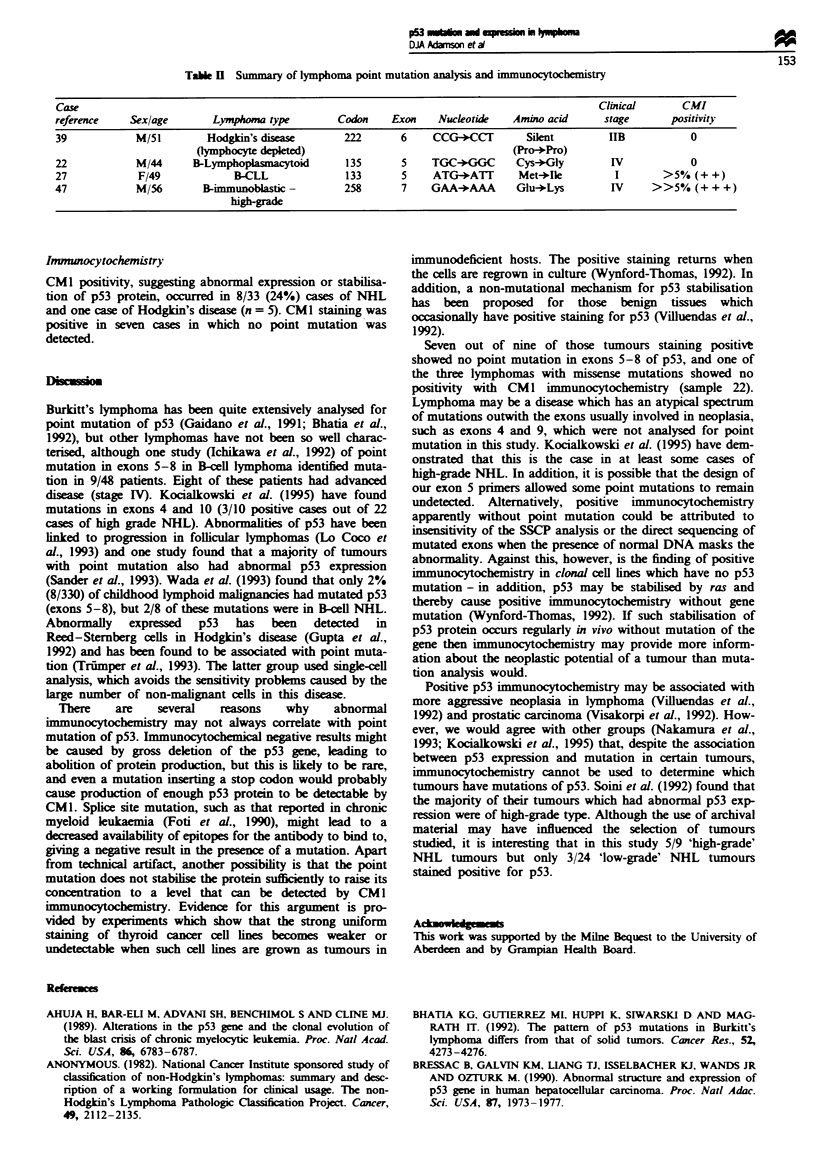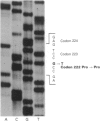Abstract
Mutation and abnormal expression of p53 was studied in 38 lymphomas [five Hodgkin's disease and 33 non-Hodgkin's lymphoma (NHL)]. CM1 polyclonal antibody was used to detect overexpression of p53. Three missense mutations were characterised in three cases of NHL after screening exons 5-8 of p53 of all the tumours with single-strand conformation polymorphism (SSCP) analysis. Only two out of three tumours with a missense mutation showed abnormal expression of p53 as measured by CM1. Conversely, seven out of nine tumours with positive CM1 staining had no point mutation demonstrated. Overexpression of p53 in the cases of NHL occurred in three out of twenty four low-grade tumours and five out of nine high-grade tumours (Kiel classification). The results suggest that abnormalities of p53 are commoner in high-grade than low-grade NHL, and that positive immunocytochemistry cannot be used to determine which tumours have mutations of p53.
Full text
PDF




Images in this article
Selected References
These references are in PubMed. This may not be the complete list of references from this article.
- Ahuja H., Bar-Eli M., Advani S. H., Benchimol S., Cline M. J. Alterations in the p53 gene and the clonal evolution of the blast crisis of chronic myelocytic leukemia. Proc Natl Acad Sci U S A. 1989 Sep;86(17):6783–6787. doi: 10.1073/pnas.86.17.6783. [DOI] [PMC free article] [PubMed] [Google Scholar]
- Bhatia K. G., Gutiérrez M. I., Huppi K., Siwarski D., Magrath I. T. The pattern of p53 mutations in Burkitt's lymphoma differs from that of solid tumors. Cancer Res. 1992 Aug 1;52(15):4273–4276. [PubMed] [Google Scholar]
- Bressac B., Galvin K. M., Liang T. J., Isselbacher K. J., Wands J. R., Ozturk M. Abnormal structure and expression of p53 gene in human hepatocellular carcinoma. Proc Natl Acad Sci U S A. 1990 Mar;87(5):1973–1977. doi: 10.1073/pnas.87.5.1973. [DOI] [PMC free article] [PubMed] [Google Scholar]
- Clarke A. R., Purdie C. A., Harrison D. J., Morris R. G., Bird C. C., Hooper M. L., Wyllie A. H. Thymocyte apoptosis induced by p53-dependent and independent pathways. Nature. 1993 Apr 29;362(6423):849–852. doi: 10.1038/362849a0. [DOI] [PubMed] [Google Scholar]
- Coles C., Thompson A. M., Elder P. A., Cohen B. B., Mackenzie I. M., Cranston G., Chetty U., Mackay J., Macdonald M., Nakamura Y. Evidence implicating at least two genes on chromosome 17p in breast carcinogenesis. Lancet. 1990 Sep 29;336(8718):761–763. doi: 10.1016/0140-6736(90)93236-i. [DOI] [PubMed] [Google Scholar]
- Foti A., Bar-Eli M., Ahuja H. G., Cline M. J. A splicing mutation accounts for the lack of p53 gene expression in a CML blast crisis cell line: a novel mechanism of p53 gene inactivation. Br J Haematol. 1990 Sep;76(1):143–145. doi: 10.1111/j.1365-2141.1990.tb07849.x. [DOI] [PubMed] [Google Scholar]
- Gaidano G., Ballerini P., Gong J. Z., Inghirami G., Neri A., Newcomb E. W., Magrath I. T., Knowles D. M., Dalla-Favera R. p53 mutations in human lymphoid malignancies: association with Burkitt lymphoma and chronic lymphocytic leukemia. Proc Natl Acad Sci U S A. 1991 Jun 15;88(12):5413–5417. doi: 10.1073/pnas.88.12.5413. [DOI] [PMC free article] [PubMed] [Google Scholar]
- Gupta R. K., Norton A. J., Thompson I. W., Lister T. A., Bodmer J. G. p53 expression in Reed-Sternberg cells of Hodgkin's disease. Br J Cancer. 1992 Oct;66(4):649–652. doi: 10.1038/bjc.1992.331. [DOI] [PMC free article] [PubMed] [Google Scholar]
- Hartwell L. Defects in a cell cycle checkpoint may be responsible for the genomic instability of cancer cells. Cell. 1992 Nov 13;71(4):543–546. doi: 10.1016/0092-8674(92)90586-2. [DOI] [PubMed] [Google Scholar]
- Hayashi K. PCR-SSCP: a simple and sensitive method for detection of mutations in the genomic DNA. PCR Methods Appl. 1991 Aug;1(1):34–38. doi: 10.1101/gr.1.1.34. [DOI] [PubMed] [Google Scholar]
- Hollstein M., Sidransky D., Vogelstein B., Harris C. C. p53 mutations in human cancers. Science. 1991 Jul 5;253(5015):49–53. doi: 10.1126/science.1905840. [DOI] [PubMed] [Google Scholar]
- Hsu S. M., Raine L., Fanger H. A comparative study of the peroxidase-antiperoxidase method and an avidin-biotin complex method for studying polypeptide hormones with radioimmunoassay antibodies. Am J Clin Pathol. 1981 May;75(5):734–738. doi: 10.1093/ajcp/75.5.734. [DOI] [PubMed] [Google Scholar]
- Ichikawa A., Hotta T., Takagi N., Tsushita K., Kinoshita T., Nagai H., Murakami Y., Hayashi K., Saito H. Mutations of p53 gene and their relation to disease progression in B-cell lymphoma. Blood. 1992 May 15;79(10):2701–2707. [PubMed] [Google Scholar]
- Iggo R., Gatter K., Bartek J., Lane D., Harris A. L. Increased expression of mutant forms of p53 oncogene in primary lung cancer. Lancet. 1990 Mar 24;335(8691):675–679. doi: 10.1016/0140-6736(90)90801-b. [DOI] [PubMed] [Google Scholar]
- Kastan M. B., Radin A. I., Kuerbitz S. J., Onyekwere O., Wolkow C. A., Civin C. I., Stone K. D., Woo T., Ravindranath Y., Craig R. W. Levels of p53 protein increase with maturation in human hematopoietic cells. Cancer Res. 1991 Aug 15;51(16):4279–4286. [PubMed] [Google Scholar]
- Kocialkowski S., Pezzella F., Morrison H., Jones M., Laha S., Harris A. L., Mason D. Y., Gatter K. C. Mutations in the p53 gene are not limited to classic 'hot spots' and are not predictive of p53 protein expression in high-grade non-Hodgkin's lymphoma. Br J Haematol. 1995 Jan;89(1):55–60. doi: 10.1111/j.1365-2141.1995.tb08911.x. [DOI] [PubMed] [Google Scholar]
- Lane D. P. Cancer. A death in the life of p53. Nature. 1993 Apr 29;362(6423):786–787. doi: 10.1038/362786a0. [DOI] [PubMed] [Google Scholar]
- Lane D. P. Cancer. p53, guardian of the genome. Nature. 1992 Jul 2;358(6381):15–16. doi: 10.1038/358015a0. [DOI] [PubMed] [Google Scholar]
- Lennert K., Collins R. D., Lukes R. J. Concordance of the Kiel and Lukes-Collins classifications of non-Hodgkin's lymphomas. Histopathology. 1983 Jul;7(4):549–559. doi: 10.1111/j.1365-2559.1983.tb02267.x. [DOI] [PubMed] [Google Scholar]
- Levine A. J., Momand J., Finlay C. A. The p53 tumour suppressor gene. Nature. 1991 Jun 6;351(6326):453–456. doi: 10.1038/351453a0. [DOI] [PubMed] [Google Scholar]
- Levine A. J. The p53 protein and its interactions with the oncogene products of the small DNA tumor viruses. Virology. 1990 Aug;177(2):419–426. doi: 10.1016/0042-6822(90)90505-l. [DOI] [PubMed] [Google Scholar]
- Lin D., Shields M. T., Ullrich S. J., Appella E., Mercer W. E. Growth arrest induced by wild-type p53 protein blocks cells prior to or near the restriction point in late G1 phase. Proc Natl Acad Sci U S A. 1992 Oct 1;89(19):9210–9214. doi: 10.1073/pnas.89.19.9210. [DOI] [PMC free article] [PubMed] [Google Scholar]
- Lo Coco F., Gaidano G., Louie D. C., Offit K., Chaganti R. S., Dalla-Favera R. p53 mutations are associated with histologic transformation of follicular lymphoma. Blood. 1993 Oct 15;82(8):2289–2295. [PubMed] [Google Scholar]
- Marx J. Many gene changes found in cancer. Science. 1989 Dec 15;246(4936):1386–1388. doi: 10.1126/science.2595361. [DOI] [PubMed] [Google Scholar]
- Mashal R., Shtalrid M., Talpaz M., Kantarjian H., Smith L., Beran M., Cork A., Trujillo J., Gutterman J., Deisseroth A. Rearrangement and expression of p53 in the chronic phase and blast crisis of chronic myelogenous leukemia. Blood. 1990 Jan 1;75(1):180–189. [PubMed] [Google Scholar]
- Midgley C. A., Fisher C. J., Bártek J., Vojtesek B., Lane D., Barnes D. M. Analysis of p53 expression in human tumours: an antibody raised against human p53 expressed in Escherichia coli. J Cell Sci. 1992 Jan;101(Pt 1):183–189. doi: 10.1242/jcs.101.1.183. [DOI] [PubMed] [Google Scholar]
- Momand J., Zambetti G. P., Olson D. C., George D., Levine A. J. The mdm-2 oncogene product forms a complex with the p53 protein and inhibits p53-mediated transactivation. Cell. 1992 Jun 26;69(7):1237–1245. doi: 10.1016/0092-8674(92)90644-r. [DOI] [PubMed] [Google Scholar]
- Nakamura H., Said J. W., Miller C. W., Koeffler H. P. Mutation and protein expression of p53 in acquired immunodeficiency syndrome-related lymphomas. Blood. 1993 Aug 1;82(3):920–926. [PubMed] [Google Scholar]
- Niedobitek G., Rowlands D. C., Young L. S., Herbst H., Williams A., Hall P., Padfield J., Rooney N., Jones E. L. Overexpression of p53 in Hodgkin's disease: lack of correlation with Epstein-Barr virus infection. J Pathol. 1993 Feb;169(2):207–212. doi: 10.1002/path.1711690206. [DOI] [PubMed] [Google Scholar]
- Nigro J. M., Baker S. J., Preisinger A. C., Jessup J. M., Hostetter R., Cleary K., Bigner S. H., Davidson N., Baylin S., Devilee P. Mutations in the p53 gene occur in diverse human tumour types. Nature. 1989 Dec 7;342(6250):705–708. doi: 10.1038/342705a0. [DOI] [PubMed] [Google Scholar]
- Pietenpol J. A., Vogelstein B. Tumour suppressor genes. No room at the p53 inn. Nature. 1993 Sep 2;365(6441):17–18. doi: 10.1038/365017a0. [DOI] [PubMed] [Google Scholar]
- Purdie C. A., Harrison D. J., Peter A., Dobbie L., White S., Howie S. E., Salter D. M., Bird C. C., Wyllie A. H., Hooper M. L. Tumour incidence, spectrum and ploidy in mice with a large deletion in the p53 gene. Oncogene. 1994 Feb;9(2):603–609. [PubMed] [Google Scholar]
- Sander C. A., Yano T., Clark H. M., Harris C., Longo D. L., Jaffe E. S., Raffeld M. p53 mutation is associated with progression in follicular lymphomas. Blood. 1993 Oct 1;82(7):1994–2004. [PubMed] [Google Scholar]
- Seruca R., David L., Holm R., Nesland J. M., Fangan B. M., Castedo S., Sobrinho-Simões M., Børresen A. L. P53 mutations in gastric carcinomas. Br J Cancer. 1992 May;65(5):708–710. doi: 10.1038/bjc.1992.149. [DOI] [PMC free article] [PubMed] [Google Scholar]
- Soini Y., Päkkö P., Alavaikko M., Vähäkangas K. p53 expression in lymphatic malignancies. J Clin Pathol. 1992 Nov;45(11):1011–1014. doi: 10.1136/jcp.45.11.1011. [DOI] [PMC free article] [PubMed] [Google Scholar]
- Szekely L., Selivanova G., Magnusson K. P., Klein G., Wiman K. G. EBNA-5, an Epstein-Barr virus-encoded nuclear antigen, binds to the retinoblastoma and p53 proteins. Proc Natl Acad Sci U S A. 1993 Jun 15;90(12):5455–5459. doi: 10.1073/pnas.90.12.5455. [DOI] [PMC free article] [PubMed] [Google Scholar]
- Takahashi T., Nau M. M., Chiba I., Birrer M. J., Rosenberg R. K., Vinocour M., Levitt M., Pass H., Gazdar A. F., Minna J. D. p53: a frequent target for genetic abnormalities in lung cancer. Science. 1989 Oct 27;246(4929):491–494. doi: 10.1126/science.2554494. [DOI] [PubMed] [Google Scholar]
- Thompson A. M., Steel C. M., Chetty U., Hawkins R. A., Miller W. R., Carter D. C., Forrest A. P., Evans H. J. p53 gene mRNA expression and chromosome 17p allele loss in breast cancer. Br J Cancer. 1990 Jan;61(1):74–78. doi: 10.1038/bjc.1990.17. [DOI] [PMC free article] [PubMed] [Google Scholar]
- Trümper L. H., Brady G., Bagg A., Gray D., Loke S. L., Griesser H., Wagman R., Braziel R., Gascoyne R. D., Vicini S. Single-cell analysis of Hodgkin and Reed-Sternberg cells: molecular heterogeneity of gene expression and p53 mutations. Blood. 1993 Jun 1;81(11):3097–3115. [PubMed] [Google Scholar]
- Villuendas R., Piris M. A., Orradre J. L., Mollejo M., Algara P., Sanchez L., Martinez J. C., Martinez P. P53 protein expression in lymphomas and reactive lymphoid tissue. J Pathol. 1992 Mar;166(3):235–241. doi: 10.1002/path.1711660305. [DOI] [PubMed] [Google Scholar]
- Visakorpi T., Kallioniemi O. P., Heikkinen A., Koivula T., Isola J. Small subgroup of aggressive, highly proliferative prostatic carcinomas defined by p53 accumulation. J Natl Cancer Inst. 1992 Jun 3;84(11):883–887. doi: 10.1093/jnci/84.11.883. [DOI] [PubMed] [Google Scholar]
- Wada M., Bartram C. R., Nakamura H., Hachiya M., Chen D. L., Borenstein J., Miller C. W., Ludwig L., Hansen-Hagge T. E., Ludwig W. D. Analysis of p53 mutations in a large series of lymphoid hematologic malignancies of childhood. Blood. 1993 Nov 15;82(10):3163–3169. [PubMed] [Google Scholar]
- Wiman K. G., Magnusson K. P., Ramqvist T., Klein G. Mutant p53 detected in a majority of Burkitt lymphoma cell lines by monoclonal antibody PAb240. Oncogene. 1991 Sep;6(9):1633–1639. [PubMed] [Google Scholar]
- Wynford-Thomas D. P53 in tumour pathology: can we trust immunocytochemistry? J Pathol. 1992 Apr;166(4):329–330. doi: 10.1002/path.1711660402. [DOI] [PubMed] [Google Scholar]
- Zhang Q., Gutsch D., Kenney S. Functional and physical interaction between p53 and BZLF1: implications for Epstein-Barr virus latency. Mol Cell Biol. 1994 Mar;14(3):1929–1938. doi: 10.1128/mcb.14.3.1929. [DOI] [PMC free article] [PubMed] [Google Scholar]
- el-Deiry W. S., Kern S. E., Pietenpol J. A., Kinzler K. W., Vogelstein B. Definition of a consensus binding site for p53. Nat Genet. 1992 Apr;1(1):45–49. doi: 10.1038/ng0492-45. [DOI] [PubMed] [Google Scholar]




